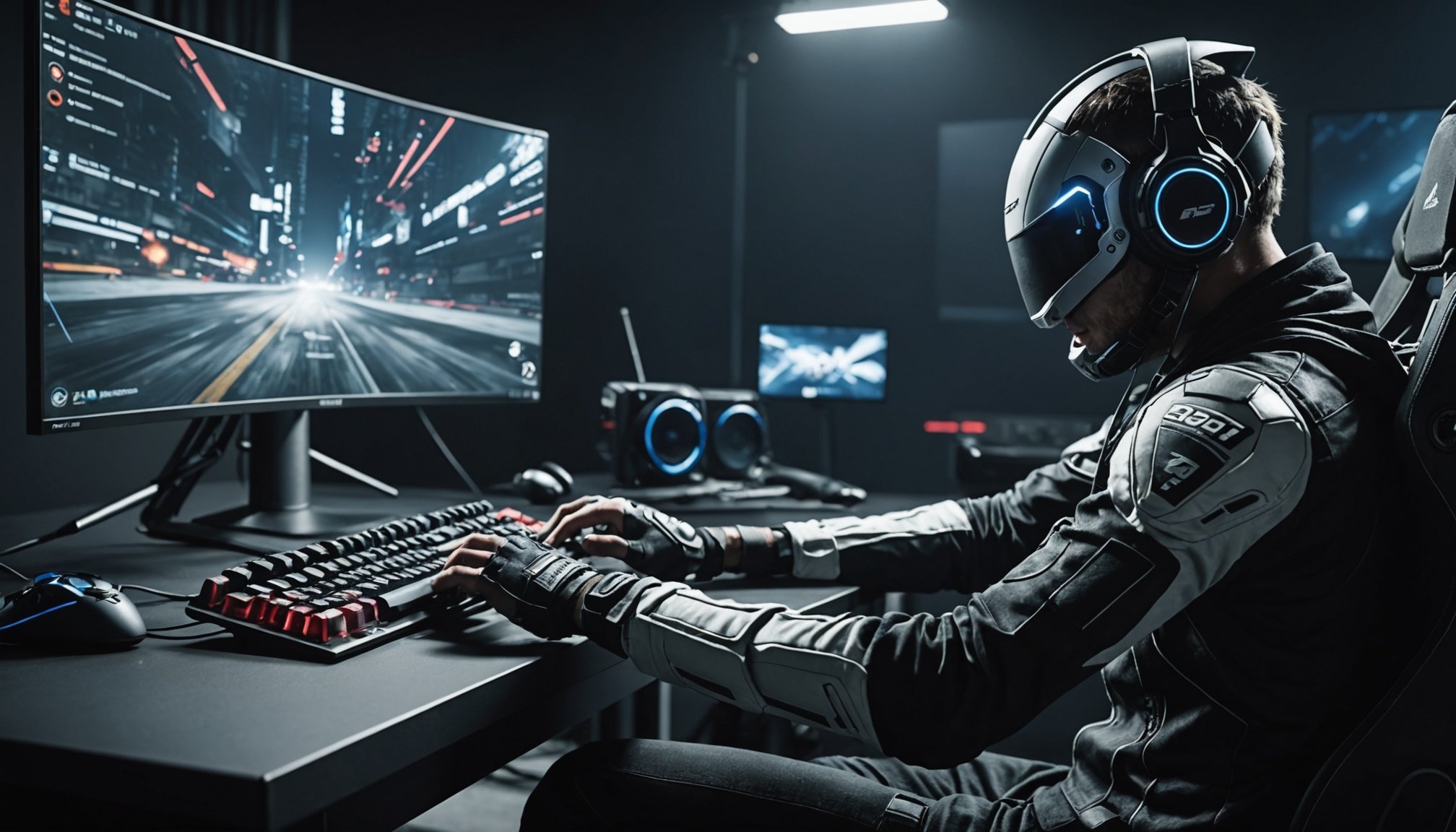Understanding Input Lag
Input lag is a lag time between pressing a button and seeing the corresponding action on the screen, crucial in competitive gaming. It affects how quickly a gamer reacts to in-game events and can influence the outcome of intense matches significantly. A seamless experience requires reduced input lag, which is why understanding and managing this factor is vital for any serious gamer.
For console performance, input lag arises from several sources. The hardware setup, including the display’s type, refresh rate, and resolution, can contribute heavily. Displays with higher refresh rates generally offer reduced input lag, enhancing game fluidity. Similarly, game settings and console configurations have a significant role; optimising these can reduce delays, creating a more responsive gaming session.
This might interest you : Navigating Challenges in Integrating Haptic Feedback into Mobile AR Games: Discovering Insights for Enhanced Gaming Experience
Misconceptions often plague discussions around input lag, with some players attributing it solely to internet connectivity. However, it’s more complex, encompassing the combined latency from the console, cable quality, and display settings. In competitive gaming, where every millisecond counts, understanding these nuances ensures players take proactive steps to optimise their setup. Adjusting gaming settings and choosing low-latency peripherals contribute positively to addressing input lag, leading to a more refined and rewarding gaming experience.
Causes of Input Lag
To tackle input lag, it is essential to understand its causes, especially within the realm of gaming hardware. Players often face latency issues due to hardware-related factors such as display types, screen resolution, and refresh rates. Higher refresh rates can significantly minimize lag, improving response times during gameplay. Conversely, lower-quality displays with substandard refresh rates contribute to heightened latency.
This might interest you : Essential Elements for Crafting Authentic Cloudscapes in Flight Simulation Games
The environment plays a crucial role as well. Proximity to the gaming console can impact performance. A greater distance can introduce delays, while using low-quality cables may amplify these issues. Ensuring optimal cable quality can reduce such latency factors, leading to improved responsiveness.
Software considerations also significantly affect input lag. Game settings and system updates should be managed often to maintain harmonious performance. Neglected settings and outdated software may inadvertently increase lag, causing a disruption in gameplay fluidity. By addressing these hardware, environmental, and software-related causes, gamers can enhance their overall gaming performance by achieving lower latency levels. Addressing these causes becomes particularly important during competitive gaming, where even minor latency can be the difference between winning and losing.
Measuring Input Lag
For gamers seeking to gain a competitive edge, understanding how to measure input lag is crucial. Various tools are available that simplify the process. Devices like the input lag tester and high-speed cameras help you determine latency differences between physical actions and on-screen reactions.
A basic testing method involves connecting your console to your display and setting up a camera to record the time between input actions and responses. Start by recording the latency in milliseconds. This quantification helps gamers to set benchmarks and track improvements over time.
Once measurements are complete, analyse the results. Lower figures indicate minimal delay, essential in competitive gaming where each millisecond can be decisive. High latency values suggest the need for system adjustments like tweaking game settings or upgrading hardware components.
Input lag tools are also helpful in verifying progress after making changes. Regular input lag testing ensures optimal console performance, fostering smoother and more responsive gameplay. Remember, consistent testing helps maintain an efficient gaming setup. Whether you’re a casual player or a pro, regularly evaluating latency and understanding its impact on response times will vastly improve your gaming strategy.
Techniques to Reduce Input Lag
Reducing input lag is key to maximizing gaming performance and can be achieved through various methods. Fine-tuning your setup ensures smoother and quicker reaction times, crucial in competitive gaming. Below, we explore strategies to enhance your overall gaming experience.
Optimizing Display Settings
Start by adjusting your display settings. Activate the game mode on your TV or monitor to minimize processing times. Ensure your display operates at the highest possible refresh rate, as this reduces lag. Also, lower resolution settings can speed up response time, contrary to some beliefs that resolution does not affect lag.
Adjusting Console Settings
Don’t overlook the importance of console configuration. Set your console to performance mode to prioritize frame rate over resolution. Disable visual enhancements that burden your system, potentially reducing input delay. Systematic firmware updates can also improve latency.
Selecting the Right Peripherals
Choosing peripherals with low latency capabilities is crucial. Gaming keyboards and mice designed for competitive gaming often come with faster response times and programmable options. Consider controllers with lower input delays, often recommended by gaming experts, to gain an edge.
Best Practices for Competitive Play
Securing an edge in competitive gaming revolves around strategic consistency and optimal performance strategies. Carefully selecting and maintaining your hardware is paramount. Pro players emphasize using the same console and displays during practice and competitions to ensure familiarity and minimize unexpected latency factors.
Routine checks and adjustments in your setup before matches can prevent potential disruptions. Evaluate connections, test audio and video settings, and verify all peripherals are functioning flawlessly. These actions reduce the possibility of encountering surprise inputs lag during crucial moments.
A dedicated gaming mindset extends beyond physical setup strategies. Preparing mentally includes developing adaptability to gameplay changes and maintaining focus under pressure. This resilience is key in navigating unexpected shifts during competitive activities, allowing players to efficiently tackle any input lag challenges.
Moreover, establishing a personal pre-game routine fosters concentration, providing a sense of control. Techniques such as visualization or controlled breathing are widely used by professionals to centre their focus and enhance performance. Maintaining this dual approach of physical preparation and mental training ensures gamers are equipped to excel in high-stakes situations, allowing them to harness their full potential.
Expert Insights and Testimonials
To delve into the world of input lag reduction, who better to guide you than the pros themselves? Let’s explore insights from competitive gamers, specialists, and case studies.
Interviews with Competitive Gamers
Professional players consistently highlight the critical impact of input lag on their performance. They stress the necessity of meticulous hardware and software setups. Small changes, like optimising game modes, have propelled many from satisfactory to stellar results in competitive gaming.
Advice from Gaming Specialists
Experts recommend routine assessments of gaming setups to minimise input lag. Effective latency management includes employing input lag tools and regularly updating systems. These precautions ensure smooth transitions in high-stakes matches, eliminating unexpected latency factors.
Case Studies of Successful Optimization
Concrete examples reflect the power of addressing input lag. One notable case involved a player who halved their delay by reconfiguring display settings and using premium cables, significantly increasing their success rate in online tournaments. Similarly, another gamer’s shift to responsive peripherals marked a pivotal performance boost, demonstrating equipment’s role in gaming hardware strategy.
Incorporating expert advice and learning from these testimonials enhances your gaming experience. Tailor your setup with recommended practices for optimal responsiveness, as guided by those who thrive under pressure.
Resources for Further Learning
Venturing into the fruitful world of input lag optimization can significantly transform your gaming sessions, particularly if competitive gaming is a priority. To delve deeper, plenty of gaming resources offer comprehensive guidance and community support, fostering a collaborative learning environment.
Begin by exploring recommended input lag articles that provide insights on reducing latency within various gaming platforms. These articles often detail intricate setups and advanced techniques that can complement your existing knowledge. Engaging with these readings arms you with the practical knowledge necessary to experiment with your console performance.
Another remarkable aspect of learning is engaging with community forums where gamers congregate to share experiences and suggestions. Here, you can post queries and find troubleshooting advice directly from peers who face similar challenges. Additionally, these forums frequently discuss console updates and influential latency factors that might affect gameplay.
For visual learners, consider seeking out video tutorials. Online video platforms host countless detailed walkthroughs focusing on optimizing setups for reduced input lag. These resources cater to diverse skill levels and increase your ability to apply learned techniques practically. With these resources at your disposal, you’ll gain the confidence to better your gaming performance efficiently.











